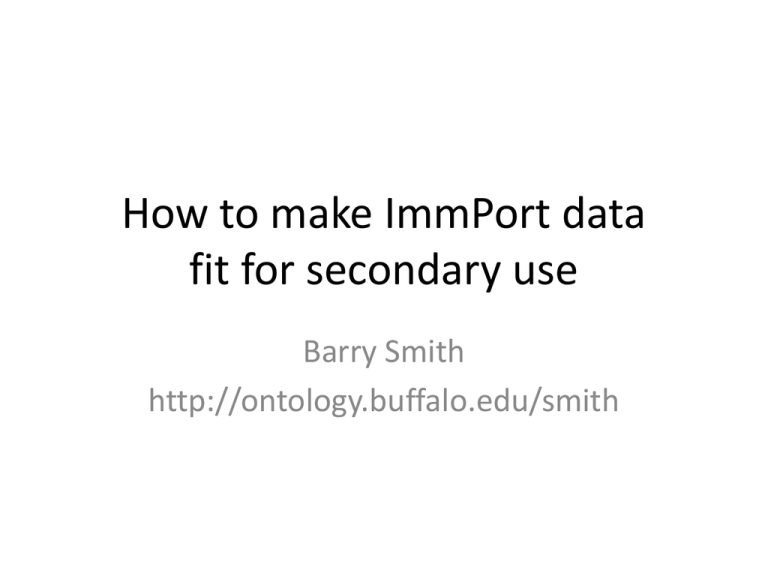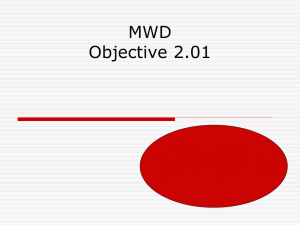ImmPort-Aug-1-2013
advertisement

How to make ImmPort data fit for secondary use Barry Smith http://ontology.buffalo.edu/smith Goals of ImmPort • Accelerate a more collaborative and coordinated research environment • Create an integrated database that broadens the usefulness of scientific data • Advance the pace and quality of scientific discovery • Integrate relevant data sets from participating laboratories, public and government databases, and private data sources • Promote rapid availability of important findings • Provide analysis tools to advance immunological research Improve immunology research through enhanced • • • • • Collaboration Coordination Discoverability Integration Analyzability Hypothesis: all of these ends will be promoted by describing ImmPort data using terms from shared high quality ontologies ImmPort data is already being tagged with ontology terms For example • where data is prepared to meet FDA requirements • where data is published to meet NIH mandates for reusability • in the post-submission phase, where data is analyzed by third parties But this tagging is • partial • uncoordinated • uses ontologies and analysis tools of varying quality SDY 165: Characterization of in vitro Stimulated B Cells from Human Subjects shared to SemiPublic Workspace (SPW) Project SDY 165: Characterization of in vitro Stimulated B Cells from Human Subjects shared to SemiPublic Workspace (SPW) Project During the human B cell (Bc) recall response, rapid cell division results in multiple Bc subpopulations. RNA microarray and functional analyses showed that proliferating CD27lo cells are a transient pre-plasmablast population, expressing genes associated with Bc receptor editing. Undivided cells had an active transcriptional program of non-ASC B cell functions, including cytokine secretion and costimulation, suggesting a link between innate and adaptive Bc responses. Transcriptome analysis suggested a gene regulatory network for CD27lo and CD27hi Bc differentiation. • In vitro stimulated B cells from human subjects • B cell receptor editing SDY 165: Characterization of in vitro Stimulated B Cells from Human Subjects shared to SemiPublic Workspace (SPW) Project Pubmed 22468229 Discoverability: examples • Find [ImmPort] data pertaining to in vitro stimulated B cells from human subjects • Find studies of genes associated with B cell receptor editing in human subjects • Find all data in public and government databases relating to B cell receptor editing Discoverability through literature search Two queries: – In vitro stimulated B cells from human subjects – B cell receptor editing on • Pubmed • MeSH (Medical Subject Headings) • Google Pubmed 22468229 PubMed retrieves 144 results for “In vitro stimulated B cells from human Subjects” – Zand paper not found PubMed retrieves 0 results for “Zand[Author] AND In vitro stimulated B cells from human subjects” Pubmed retrieves 179 results for “B cell receptor editing” – Zand paper not found MeSH results for “In vitro stimulated B cells from human subjects” MeSH results for “in vitro stimulated B cells from human subjects” MeSH results for “B Cell receptor editing” Google retrieves 180 results for “In vitro stimulated B cells from human subjects” – Zand paper not found Jackpot How to make this [ImmPort data] SDY 165: Characterization of in vitro Stimulated B Cells from Human Subjects shared to Semi-Public Workspace (SPW) Project During the human B cell (Bc) recall response, rapid cell division results in multiple Bc subpopulations. RNA microarray and functional analyses showed that proliferating CD27lo cells are a transient pre-plasmablast population, expressing genes associated with Bc receptor editing. Undivided cells had an active transcriptional program of non-ASC B cell functions, including cytokine secretion and costimulation, suggesting a link between innate and adaptive Bc responses. Transcriptome analysis suggested a gene regulatory network for CD27lo and CD27hi Bc differentiation. discoverable? B cell receptor editing GO:0002452 GO definition GO provides a definition and position in GO hierarchy -- hierarchy allows logical reasoning GOPubMed: 179 results for “B cell receptor editing” (B cell receptor editing Zand) AND ("Zand"[au]) why are zero documents retrieved? Proposal 1. Tag ImmPort SDY abstracts with GO URIs 2. Publish the results to the GO Annotation database During the human B cell recall response, rapid cell division results in multiple B cell subpopulations. RNA microarray and functional analyses showed that proliferating CD27lo cells are a transient pre-plasmablast population, expressing genes associated with B cell receptor editing. Undivided cells had an active transcriptional program of non-ASC B cell functions, including cytokine secretion and costimulation, suggesting a link between innate and adaptive Bc responses. Transcriptome analysis suggested a gene regulatory network for CD27lo and CD27hi Bc But GO is not enough See http://ncorwiki.buffalo.edu/index.php/ Immunology_Ontologies immune disorders infectious diseases allergies immune epitopes, etc. etc. For special case of Flow Cytometry and CyTOF: ImmPort Ontology Meeting, Stanford, September 4-5, 2013: http://x.co/1W1Om Files in SDY 165 lk_race.txt American Indian or Alaska Native Asian Black or African American Native Hawaiian or Other Pacific Islander Not_Specified Other Unknown White ImmPort Templates https://immport.niaid.nih.gov/immportWeb/experimental/ displaySubmitTemplates.do ImmPort Templates: Race https://immport.niaid.nih.gov/immportWeb/experimental/ displaySubmitTemplates.do ImmPort Templates How specify Race if Race = ‘Other’? ImmPort Templates How specify “Subject Phenotype”? NG / BISC proposal create controlled vocabularies (ontology drop down lists) for fields currently populated by submitters with free text Files in SDY 165 lk_sample_type proposal: where controlled vocabularies exist, provide definitions for all terms Two kinds of definitions • human readable definitions support consistency of data entry • logical definitions – allow logical analysis of data – support aggregation of data – allow automatic validation of consistent data entry Definitions can often be taken over from already existing public domain ontologies such as GO • use of ready-made definitions supports discoverability, and creates automatic linkage to huge bodies of public domain data ImmPort Antibody Registry (Diehl, et al) from BD Lyoplate Screening Panels Human Surface Markers Discoverability Where did this lk_sample_type list come from? CDISC • Clinical Data Interchange Standards Consortium • http://www.cdisc.org/ CDISC Glossary SDTM • Study Data Tabulation Model developed by FDA as part of CDISC – for Race, Gender, Ethnicity, … – no human readable definitions – no logical definitions Jan 2013: release of CDISC SDTM Model by CDISC2RDF (Kerstin Forsberg of AstraZeneca) PHUSE (EU, Roche, AstraZeneca, FDA, …) project to incorporate ontology technology into CDISC BRIDG • http://bridgmodel.nci.nih.gov/files/BRIDG_M odel_3.2_html/index.htm • Biomedical Research Integrated Domain Group (BRIDG) Project BRIDG 3.2 Domain Analysis Model Other strategies to simplify creation of structured data for submission into ImmPort • ELN: Electronic Lab Notebooks – PRIME: “Contur ELN has been automating the process of data deposition into ImmPort, making it much easier for our researchers to submit data to ImmPort” • CTMS: Clinical Trial Management Systems • EHR: Electronic Health Records – experiments to prepopulate EHR data into CTMS and from there into case report forms (and into ImmPort?) • Minimal Information Checklists MIFLOWCYT: Minimal Information for a Flow Cytometry Experiment Checklist strategy for creating public data repositories via journals • 75% of articles in Cytometry A are MiFlowCyt compliant • Result: a growing repository of flow cytometry data (flowrepository.org) • OBI = Ontology for Biomedical Investigations, an ontology to support creation of structured data about clinical and biological experiments http://mibbi.sourceforge.net/portal.shtml Proposal advertise on ImmPort website best (= most successful) practices from • ELN: Electronic Lab Notebooks • CTMS: Clinical Trial Management Systems • EHR: Electronic Health Records • Minimal Information Checklists NIAID Sample Data Sharing Plan (Last Reviewed February 12, 2013) • Sharing of data generated by this project is an essential part of our proposed activities and will be carried out in several different ways. • Presentations at national scientific meetings. … it is expected that approximately four presentations at national meetings would be appropriate. … • Annual lectureship. A lectureship has brought to the University distinguished scientists and clinicians … • Newsletter. The [disease interest group] publishes a newsletter … • Web site of the Interest Group. The [interest group] currently maintains a Web site where information [about the disease] is posted … • Annual [Disease] Awareness week…. • SAGE Library Data. It is our explicit intention that these [Serial analysis of gene expression] data will be placed in a readily accessible public database. … NIAID Sample Data Sharing Plan • SAGE Library Data. It is our explicit intention that these [Serial analysis of gene expression] data will be placed in a readily accessible public database. … –but how will these data be described? Proposal All data sharing plans for NIAID-funded research should require: • paper abstracts and SDY summaries be tagged with ontology terms • tables and figures in papers be tagged with ontology terms See http://ncorwiki.buffalo.edu/index.php/ Immunology_Ontologies ImmPort Ontology Meeting, Stanford, September 4-5, 2013: http://x.co/1W1Om Further information from phismith@buffalo.edu









![Shark Electrosense: physiology and circuit model []](http://s2.studylib.net/store/data/005306781_1-34d5e86294a52e9275a69716495e2e51-300x300.png)